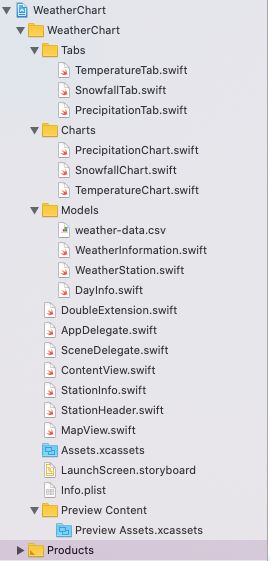版本记录
| 版本号 | 时间 |
|---|---|
| V1.0 | 2020.01.10 星期五 |
前言
今天翻阅苹果的API文档,发现多了一个框架SwiftUI,这里我们就一起来看一下这个框架。感兴趣的看下面几篇文章。
1. SwiftUI框架详细解析 (一) —— 基本概览(一)
2. SwiftUI框架详细解析 (二) —— 基于SwiftUI的闪屏页的创建(一)
3. SwiftUI框架详细解析 (三) —— 基于SwiftUI的闪屏页的创建(二)
4. SwiftUI框架详细解析 (四) —— 使用SwiftUI进行苹果登录(一)
5. SwiftUI框架详细解析 (五) —— 使用SwiftUI进行苹果登录(二)
6. SwiftUI框架详细解析 (六) —— 基于SwiftUI的导航的实现(一)
7. SwiftUI框架详细解析 (七) —— 基于SwiftUI的导航的实现(二)
8. SwiftUI框架详细解析 (八) —— 基于SwiftUI的动画的实现(一)
9. SwiftUI框架详细解析 (九) —— 基于SwiftUI的动画的实现(二)
10. SwiftUI框架详细解析 (十) —— 基于SwiftUI构建各种自定义图表(一)
源码
1. Swift
首先看下工程组织结构
下面就是源码了
1. TemperatureTab.swift
import SwiftUI
struct TemperatureTab: View {
var station: WeatherStation
var body: some View {
VStack {
Text("Temperatures for 2018")
TemperatureChart(measurements: station.measurements)
}.padding()
}
}
struct TemperatureTab_Previews: PreviewProvider {
static var previews: some View {
TemperatureTab(station: WeatherInformation()!.stations[0])
}
}
2. SnowfallTab.swift
import SwiftUI
struct SnowfallTab: View {
var station: WeatherStation
var body: some View {
VStack {
Text("Snowfall for 2018")
SnowfallChart(snowfall: self.station.measurements.filter { $0.snowfall > 0.0 })
}
}
}
struct SnowfallTab_Previews: PreviewProvider {
static var previews: some View {
SnowfallTab(station: WeatherInformation()!.stations[2])
}
}
3. PrecipitationTab.swift
import SwiftUI
struct PrecipitationTab: View {
var station: WeatherStation
func monthFromName(_ name: String) -> Int {
let df = DateFormatter()
df.dateFormat = "LLLL"
if let date = df.date(from: name) {
return Calendar.current.component(.month, from: date)
}
return 0
}
var body: some View {
VStack {
Text("Precipitation for 2018")
PrecipitationChart(measurements: station.measurements)
}
}
}
struct PrecipitationTab_Previews: PreviewProvider {
static var previews: some View {
PrecipitationTab(station: WeatherInformation()!.stations[2])
}
}
4. PrecipitationChart.swift
import SwiftUI
struct PrecipitationChart: View {
var measurements: [DayInfo]
func sumPrecipitation(_ month: Int) -> Double {
self.measurements
.filter {
Calendar.current.component(.month, from: $0.date) == month + 1
}
.reduce(0) { $0 + $1.precipitation }
}
func monthAbbreviationFromInt(_ month: Int) -> String {
let ma = Calendar.current.shortMonthSymbols
return ma[month]
}
var body: some View {
// 1
HStack {
// 2
ForEach(0..<12) { month in
// 3
VStack {
// 4
Spacer()
Text("\(self.sumPrecipitation(month).stringToOneDecimal)")
.font(.footnote)
.rotationEffect(.degrees(-90))
.offset(y: self.sumPrecipitation(month) < 2.4 ? 0 : 35)
.zIndex(1)
// 5
Rectangle()
.fill(Color.green)
.frame(width: 20, height: CGFloat(self.sumPrecipitation(month)) * 15.0)
// 6
Text("\(self.monthAbbreviationFromInt(month))")
.font(.footnote)
.frame(height: 20)
}
}
}
}
}
struct PrecipitationChart_Previews: PreviewProvider {
static var previews: some View {
PrecipitationChart(measurements: WeatherInformation()!.stations[2].measurements)
}
}
5. SnowfallChart.swift
import SwiftUI
struct SnowfallChart: View {
var snowfall: [DayInfo]
var body: some View {
// 1
List(snowfall.filter { $0.snowfall > 0.0 }) { measurement in
HStack {
// 2
Text("\(measurement.dateString)")
.frame(width: 100, alignment: .trailing)
// 3
ZStack(alignment: .leading) {
ForEach(0..<17) { mark in
Rectangle()
.fill(mark % 5 == 0 ? Color.black : Color.gray)
.offset(x: CGFloat(mark) * 10.0)
.frame(width: 1.0)
.zIndex(1)
}
Rectangle()
.fill(Color.blue)
.frame(width: CGFloat(measurement.snowfall * 10.0), height: 5.0)
}
// 4
Spacer()
Text("\(measurement.snowfall.stringToOneDecimal)\"")
}
}
}
}
struct SnowfallChart_Previews: PreviewProvider {
static var previews: some View {
SnowfallChart(snowfall: WeatherInformation()!.stations[2].measurements)
}
}
6. TemperatureChart.swift
import SwiftUI
struct TemperatureChart: View {
var measurements: [DayInfo]
let tempGradient = Gradient(colors: [
.purple,
Color(red: 0, green: 0, blue: 139.0/255.0),
.blue,
Color(red: 30.0/255.0, green: 144.0/255.0, blue: 1.0),
Color(red: 0, green: 191/255.0, blue: 1.0),
Color(red: 135.0/255.0, green: 206.0/255.0, blue: 250.0/255.0),
.green,
.yellow,
.orange,
Color(red: 1.0, green: 140.0/255.0, blue: 0.0),
.red,
Color(red: 139.0/255.0, green: 0.0, blue: 0.0)
])
func degreeHeight(_ height: CGFloat, range: Int) -> CGFloat {
height / CGFloat(range)
}
func dayWidth(_ width: CGFloat, count: Int) -> CGFloat {
width / CGFloat(count)
}
func dayOffset(_ date: Date, dWidth: CGFloat) -> CGFloat {
CGFloat(Calendar.current.ordinality(of: .day, in: .year, for: date)!) * dWidth
}
func tempOffset(_ temperature: Double, degreeHeight: CGFloat) -> CGFloat {
CGFloat(temperature + 10) * degreeHeight
}
func tempLabelOffset(_ line: Int, height: CGFloat) -> CGFloat {
height - self.tempOffset(Double(line * 10),
degreeHeight: self.degreeHeight(height, range: 110))
}
func offsetFirstOfMonth(_ month: Int, width: CGFloat) -> CGFloat {
let dateFormatter = DateFormatter()
dateFormatter.dateFormat = "M/d/yyyy"
let foM = dateFormatter.date(from: "\(month)/1/2018")!
let dayWidth = self.dayWidth(width, count: 365)
return self.dayOffset(foM, dWidth: dayWidth)
}
func monthAbbreviationFromInt(_ month: Int) -> String {
let ma = Calendar.current.shortMonthSymbols
return ma[month - 1]
}
var body: some View {
// 1
GeometryReader { reader in
ForEach(self.measurements) { measurement in
// 2
Path { p in
// 3
let dWidth = self.dayWidth(reader.size.width, count: 365)
let dHeight = self.degreeHeight(reader.size.height, range: 110)
// 4
let dOffset = self.dayOffset(measurement.date, dWidth: dWidth)
// 5
let lowOffset = self.tempOffset(measurement.low, degreeHeight: dHeight)
let highOffset = self.tempOffset(measurement.high, degreeHeight: dHeight)
// 6
p.move(to: .init(x: dOffset, y: reader.size.height - lowOffset))
p.addLine(to: .init(x: dOffset, y: reader.size.height - highOffset))
// 7
}.stroke(LinearGradient(
gradient: self.tempGradient,
startPoint: .init(x: 0.0, y: 1.0),
endPoint: .init(x: 0.0, y: 0.0)))
}
// 1
ForEach(-1..<11) { line in
// 2
Group {
Path { path in
// 3
let y = self.tempLabelOffset(line, height: reader.size.height)
path.move(to: CGPoint(x: 0, y: y))
path.addLine(to: CGPoint(x: reader.size.width, y: y))
// 4
}.stroke(line == 0 ? Color.black : Color.gray)
// 5
if line >= 0 {
Text("\(line * 10)°")
.offset(x: 10, y: self.tempLabelOffset(line, height: reader.size.height))
}
}
}
ForEach(1..<13) { month in
Group {
Path { path in
let dOffset = self.offsetFirstOfMonth(month, width: reader.size.width)
path.move(to: CGPoint(x: dOffset, y: reader.size.height))
path.addLine(to: CGPoint(x: dOffset, y: 0))
}.stroke(Color.gray)
Text("\(self.monthAbbreviationFromInt(month))")
.font(.subheadline)
.offset(
x: self.offsetFirstOfMonth(month, width: reader.size.width) +
5 * self.dayWidth(reader.size.width, count: 365),
y: reader.size.height - 25.0)
}
}
}
}
}
struct TemperatureChart_Previews: PreviewProvider {
static var previews: some View {
TemperatureChart(measurements: WeatherInformation()!.stations[2].measurements)
}
}
7. WeatherInformation.swift
import Foundation
class WeatherInformation {
var stations: [WeatherStation]
init?() {
// Init empty array
stations = []
// Converter for date string
let dateFormatter = DateFormatter()
dateFormatter.dateFormat = "M/d/yyyy"
// Get CSV data
guard let csvData = getCsvAsString() else { return nil }
var currentStationId = ""
var currentStation: WeatherStation?
// Parse each line
csvData.enumerateLines { (line, _) in
let cols = line.components(separatedBy: ",")
if currentStationId != cols[0] {
if let newStation = currentStation {
if newStation.name != "NAME" {
self.stations.append(newStation)
}
}
currentStationId = cols[0]
let name = cols[1].replacingOccurrences(of: "\"", with: "").replacingOccurrences(of: ";", with: ",")
let lat = Double(cols[2]) ?? 0
let lng = Double(cols[3]) ?? 0
let alt = Int((Double(cols[4]) ?? 0) * 3.28084) // m to ft.
currentStation = WeatherStation(id: currentStationId, name: name, latitude: lat, longitude: lng, altitude: alt, measurements: [])
}
let date = dateFormatter.date(from: cols[5]) ?? dateFormatter.date(from: "1/1/2018")!
let precip = Double(cols[6]) ?? 0
let snow = Double(cols[7]) ?? 0
let high = Double(cols[8]) ?? 0
let low = Double(cols[9]) ?? 0
let newData = DayInfo(date: date, precipitation: precip, snowfall: snow, high: high, low: low)
currentStation?.measurements.append(newData)
}
// Add the last station read
if let newStation = currentStation {
self.stations.append(newStation)
}
}
func getCsvAsString() -> String? {
guard let fileURL = Bundle.main.url(forResource: "weather-data", withExtension: "csv") else { return nil }
do {
let csvData = try String(contentsOf: fileURL)
return csvData
} catch {
return nil
}
}
}
8. WeatherStation.swift
import Foundation
struct WeatherStation: Identifiable {
var id: String
var name: String
var latitude: Double
var longitude: Double
var altitude: Int
var measurements: [DayInfo]
func measurementsInMonth(_ month: Int) -> [DayInfo] {
return measurements.filter {
return Calendar.current.component(.month, from: $0.date) == month
}
}
var lowTemperatureForYear: Double {
measurements.min(by: { $0.low < $1.low })!.low
}
var highTemperatureForYear: Double {
measurements.max(by: { $0.high < $1.high })!.high
}
}
9. DayInfo.swift
import Foundation
struct DayInfo : Identifiable {
var date: Date
var precipitation: Double
var snowfall: Double
var high: Double
var low: Double
var id: Date {
return date
}
var dateString: String {
let dateFormatter = DateFormatter()
dateFormatter.dateFormat = "M/d/yyyy"
return dateFormatter.string(from: date)
}
}
10. DoubleExtension.swift
import Foundation
extension Double {
var stringToOneDecimal: String {
String(format: "%.1f", self)
}
var stringToTwoDecimals: String {
String(format: "%.2f", self)
}
var stringRounded: String {
String(format: "%.f", self.rounded())
}
var asLatitude: String {
let deg = floor(self)
let min = fabs(self.truncatingRemainder(dividingBy: 1) * 60.0).rounded()
if self > 0 {
return String(format: "%.f° %.f\" N", deg, min)
} else if self < 0 {
return String(format: "%.f° %.f\" S", -deg, min)
}
return "0°"
}
var asLongitude: String {
let deg = floor(self)
let min = fabs(self.truncatingRemainder(dividingBy: 1) * 60.0).rounded()
if self > 0 {
return String(format: "%.f° %.f\" E", deg, min)
} else if self < 0 {
return String(format: "%.f° %.f\" W", -deg, min)
}
return "0°"
}
}
11. AppDelegate.swift
import UIKit
@UIApplicationMain
class AppDelegate: UIResponder, UIApplicationDelegate {
// MARK: - UISceneSession Lifecycle
func application(_ application: UIApplication, configurationForConnecting connectingSceneSession: UISceneSession, options: UIScene.ConnectionOptions) -> UISceneConfiguration {
// Called when a new scene session is being created.
// Use this method to select a configuration to create the new scene with.
return UISceneConfiguration(name: "Default Configuration", sessionRole: connectingSceneSession.role)
}
}
12. SceneDelegate.swift
import UIKit
import SwiftUI
class SceneDelegate: UIResponder, UIWindowSceneDelegate {
var window: UIWindow?
func scene(_ scene: UIScene, willConnectTo session: UISceneSession, options connectionOptions: UIScene.ConnectionOptions) {
// Use this method to optionally configure and attach the UIWindow `window` to the provided UIWindowScene `scene`.
// If using a storyboard, the `window` property will automatically be initialized and attached to the scene.
// This delegate does not imply the connecting scene or session are new (see `application:configurationForConnectingSceneSession` instead).
// Use a UIHostingController as window root view controller
if let windowScene = scene as? UIWindowScene {
let window = UIWindow(windowScene: windowScene)
window.rootViewController = UIHostingController(rootView: ContentView())
self.window = window
window.makeKeyAndVisible()
}
}
}
13. ContentView.swift
import SwiftUI
struct ContentView: View {
let stations = WeatherInformation()
var body: some View {
NavigationView {
VStack {
List(stations!.stations) { station in
NavigationLink(destination: StationInfo(station: station)) {
Text("\(station.name)")
}
}
Text("Source: https://www.ncdc.noaa.gov/cdo-web/datasets")
.italic()
}.navigationBarTitle(Text("Weather Stations"))
}
}
}
struct ContentView_Previews: PreviewProvider {
static var previews: some View {
ContentView()
}
}
14. StationInfo.swift
import SwiftUI
struct StationInfo: View {
var station: WeatherStation
var body: some View {
VStack {
StationHeader(station: self.station)
.padding()
TabView {
TemperatureTab(station: self.station)
.tabItem({
Image(systemName: "thermometer")
Text("Temperatures")
})
SnowfallTab(station: self.station)
.tabItem({
Image(systemName: "snow")
Text("Snowfall")
})
PrecipitationTab(station: self.station)
.tabItem({
Image(systemName: "cloud.rain")
Text("Precipitation")
})
}
}.navigationBarTitle(Text("\(station.name)"), displayMode: .inline)
}
}
struct StationInfo_Previews: PreviewProvider {
static var previews: some View {
StationInfo(station: WeatherInformation()!.stations[0])
}
}
15. StationHeader.swift
import SwiftUI
struct StationHeader: View {
var station: WeatherStation
var body: some View {
HStack {
VStack(alignment: .leading) {
Text("Latitude: \(station.latitude.asLatitude)")
Text("Longitude: \(station.longitude.asLongitude)")
Text("Elevation: \(station.altitude) ft.")
}
Spacer()
MapView(latitude: station.latitude, longitude: station.longitude)
.frame(width: 200, height: 200)
}
}
}
struct StationHeader_Previews: PreviewProvider {
static var previews: some View {
StationHeader(station: WeatherInformation()!.stations[1])
}
}
16. MapView.swift
import SwiftUI
import MapKit
struct MapView: UIViewRepresentable {
var latitude: Double
var longitude: Double
func makeUIView(context: Context) -> MKMapView {
MKMapView(frame: .zero)
}
func updateUIView(_ view: MKMapView, context: Context) {
let coordinate = CLLocationCoordinate2D(
latitude: self.latitude,
longitude: self.longitude)
let span = MKCoordinateSpan(latitudeDelta: 0.15, longitudeDelta: 0.15)
let region = MKCoordinateRegion(center: coordinate, span: span)
view.setRegion(region, animated: true)
view.mapType = .hybrid
view.isScrollEnabled = false
}
}
struct MapView_Previews: PreviewProvider {
static var previews: some View {
MapView(latitude: 34.011286, longitude: -116.166868)
}
}
后记
本篇主要讲述了基于SwiftUI构建各种自定义图表,感兴趣的给个赞或者关注~~~

